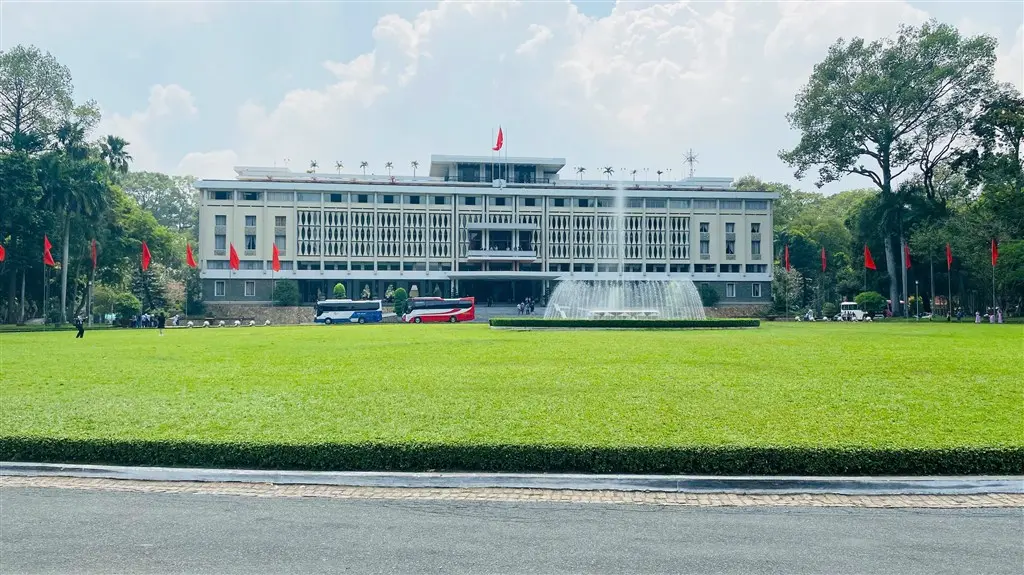The history of Vietnam presents a rich tapestry. It shows resilience, cultural brilliance, and an unyielding spirit of independence. This story spans millennia, from ancient peoples to powerful Vietnamese dynasties. It covers periods of foreign domination and intense conflict. Ultimately, it leads to a unified, modern nation. Understanding vietnam history is vital.
It helps appreciate this Southeast Asian gem. It also aids in grasping broader themes in Asian history and World history. This journey through historical vietnam offers insights. We see the impact of French colonization on Vietnamese society. We learn about key figures in Vietnam’s struggle for independence. We understand the complex consequences of the Vietnam War for civilians.
At EssentialVietNamtravel.com, we believe knowing a country means understanding its past. This guide provides a vietnam history overview. It aims to help learn about key periods in Vietnamese history. It explores the nation’s enduring legacy. The narrative of vietnam’s history is complex. It reflects cyclical unification. It shows a deep-rooted national identity, evolved over time.
An Overview of Key Periods Shaping Vietnam’s History
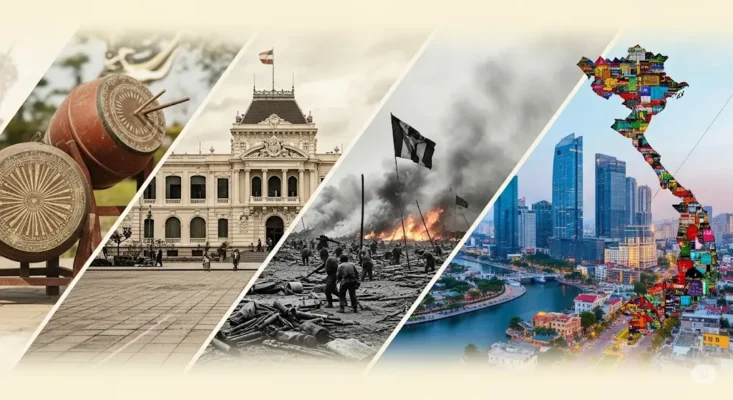
The chronicle of vietnam history unfolds over thousands of years. Distinct eras have profoundly shaped its identity. This overview touches upon foundational periods. These include earliest inhabitants and ancient kingdoms. It covers long, influential dynastic periods. During these, Vietnamese culture and governance flourished. We then explore colonial interventions, particularly French Indochina.
This dramatically altered the socio-political landscape. It sowed seeds for future conflicts. Finally, we examine the path to modern independence. This includes struggles for reunification and the emergence of contemporary Vietnam. Each phase contributes to the history of vietnam. This summary of vietnam history provides a base before deeper dives. Historical events are interconnected. Understanding these connections is key to the nation’s journey. The history in vietnam shows resilience against invasion. This vietnam history summary provides a concise look at these pivotal moments, essential for anyone wanting to know what is the history of vietnam.
From Ancient Origins to Early Dynasties
The story of vietnam history begins before written records. Archaeological evidence points to early human settlements. The Dong Son cultural origins are significant. They laid a foundation for Vietnamese identity. Various groups coalesced, forming early states and Vietnamese kingdoms. These initial polities faced internal and external pressures. This included interactions with expanding Chinese empires.
The origin of vietnam is rooted in these early struggles for autonomy. From what years did vietnam’s first dynasty last? Pinpointing a “first” dynasty is complex. The Hong Bang dynasty is often cited, though partly legendary. More verifiable entities followed. Understanding this ancient period is crucial to learn about key periods in Vietnamese history. The establishment of early Vietnamese kingdoms set precedents for development and sovereignty efforts.
The Impact of Colonial Eras
No discussion of vietnamese history is complete without colonial eras. Chinese domination occurred over centuries, shaping governance and culture. More recent French colonization, starting with French Indochina in 1887, brought transformative changes. This foreign intervention impacted sovereignty greatly. The French administration restructured the economy.
It introduced new social hierarchies and exploited resources. This led to widespread discontent. Colonialism led to nationalism. The Vietnamese people sought to reclaim autonomy. The impact of French colonization on Vietnamese society was multifaceted. It affected land ownership, education, and daily life. This era is critical to Southeast Asian history and post-colonial studies. It highlights struggles against external powers. Many 20th-century conflicts began here.
The Path to Modern Independence and Unity
The 20th century saw Vietnam’s journey to modern independence and unity. Fueled by colonial rule and nationalism, key figures in Vietnam’s struggle for independence emerged. Ho Chi Minh was most notable. His leadership was central against French Indochina and other foreign powers. The Indochina Wars, including the First Indochina War and the Vietnam War, marked this conflict period.
War resulted in division and reunification, a painful, pivotal chapter in vietnam history. Vietnam’s independence declared in 1945 was a watershed moment. True sovereignty took decades more. The consequences of the Vietnam War for civilians were devastating. They shaped the nation’s psyche. This period underscores Vietnamese resilience and determination.
Ancient Vietnam: The Dong Son Culture and Early Kingdoms like Annam and Champa
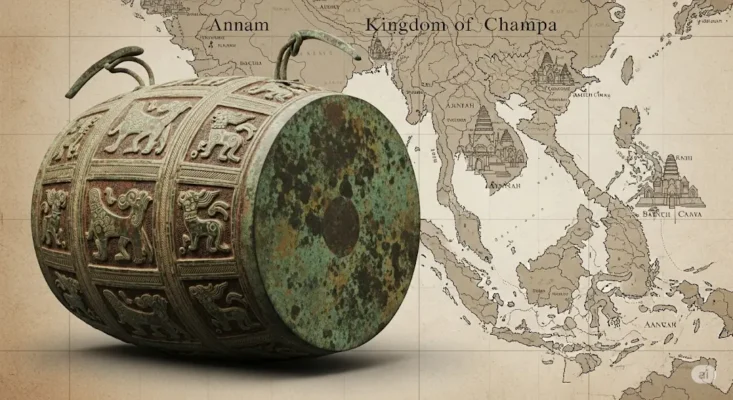
Ancient Vietnam reveals indigenous cultures and early state formations. These laid the groundwork for the nation’s identity. Before known dynastic periods, societies flourished. The Dong Son culture, with iconic bronze drums, shows early artistic and technological prowess in northern Vietnam. To the south, other Vietnamese kingdoms emerged.
The Kingdom of Champa developed a unique cultural trajectory, often interacting with northern neighbors. The territory historically called Annam by outsiders encompassed parts of these early heartlands. Exploring ancient Vietnamese civilization offers a glimpse into the roots of Vietnamese resilience and cultural identity. This era, marked by syncretic belief systems, is fundamental to understanding the origin of vietnam. It is a core part of any brief history of vietnam.
The Significance of the Dong Son Bronze Drums and Culture
The Dong Son culture flourished in the Red River Delta from around 1000 BCE to 1st century CE. It is a cornerstone of ancient vietnam history. Its Dong Son drum is more than an instrument. It’s a symbol of power, a ritual object, a historical record. These drums depict daily life, warfare, ceremonies, and myths. They offer insights into Dong Son beliefs and social structures.
The Dong Son cultural origins are foundational to Vietnamese identity. They showcase advanced bronze-casting and distinct art. The drums’ prevalence across Southeast Asia points to trade and cultural exchange. Their symbolism connects to early Vietnamese folklore, pre-dating later adopted faiths. Understanding Dong Son culture is understanding a deep layer of history in vietnam. The Dong Son drum remains a powerful symbol.
Exploring the Kingdom of Champa and its Influence
While Dong Son thrived north, central and southern coasts housed the Kingdom of Champa. Flourishing from 2nd to 15th centuries CE, Champa was distinct, with a maritime heritage. Influenced by India, Chams adopted Hinduism (Shaivism) and later Islam. This is reflected in their temple architecture and sculpture. Cham were skilled seafarers and traders.
Their kingdom often rivaled Dai Viet, the Vietnamese state north. Champa’s history involves dynamic interaction: peace, trade, conflict. The legacy of the Kingdom of Champa is visible today in the Cham ethnic minority, their language, customs, and ruins like My Son, a UNESCO site. It offers a window into Southeast Asian conflicts and cultural exchange.
Early Interactions and Periods of Chinese Rule in Annam
Northern Vietnam, often called Annam or Tonkin, experienced long interaction with China. From 2nd century BCE, it fell under Chinese domination for about 1000 years. This period profoundly influenced Vietnamese society, governance, and culture. Chinese rule brought Confucianism, a writing system, and administrative structures. It also fostered strong Vietnamese resistance and desire for independence.
Numerous rebellions occurred, led by heroes celebrated in vietnam history. This resistance to Chinese domination became a defining Vietnamese trait. Vietnamese people adapted and assimilated influences while preserving core culture. This resilience shaped the political landscape. It set the stage for independent Vietnamese dynasties.
The Great Dynastic Eras: Shaping Dai Viet with the Ly, Tran, and Nguyen Dynasties
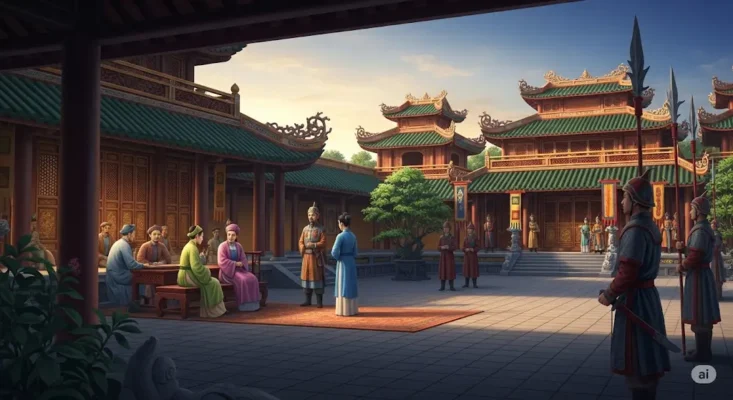
After Chinese rule, Vietnam entered an era of independence. Powerful Vietnamese dynasties emerged. These ruling houses consolidated the nation, expanded territory, and fostered identity under Dai Viet, a historical name for Vietnam. The Ly Dynasty, Tran Dynasty, and later, Nguyen Dynasty (the last imperial family) were influential. Each vietnam dynasty contributed to political, social, and cultural development. They left legacies in governance, military strategy, art, and literature.
This period of dynastic periods shows cyclical unification. The nation would fragment then reunite. Figures like Le Loi, who defeated Ming Dynasty invaders and founded the Later Le Dynasty, exemplify this spirit. Emperor Le Vietnam is a celebrated figure. Understanding these dynasties is key to researching specific Vietnamese dynasties or rulers. It shows the depth of history vietnam offers. The list of vietnamese dynasties is rich, each with its story. A history of vietnam must detail these influential dynasties of vietnam.
Golden Ages Under the Ly Dynasty and Tran Dynasty
The Ly Dynasty (1009-1225) is a golden age in vietnam’s history. They moved the capital to Thang Long (Hanoi), a political and cultural hub. The Ly Dynasty established stable, centralized government. It promoted Buddhism, influencing Vietnamese culture. It fostered agricultural, dike construction, and educational advancements, founding the Temple of Literature.
The Tran Dynasty (1225-1400) continued this legacy. The Tran are famous for military victories, repelling three Mongol invasions in the 13th century. Tran Hung Dao, famous for defeating Mongols, is legendary. Both Ly Dynasty and Tran Dynasty saw significant cultural development. This included ceramics, poetry, and architecture, solidifying Dai Viet’s foundations. The cultural development during the Ly Dynasty was particularly vital for historical vietnam.
The Rise and Rule of the Nguyen Dynasty, including figures like Bao Dai
The Nguyen Dynasty (1802-1945) was Vietnam’s last. Its rule spanned significant change. Established by Emperor Gia Long with Hue as capital, it initially consolidated a unified Vietnam. They implemented Confucian systems and focused on cultural preservation. Their reign coincided with Western colonial expansion. Vietnam gradually fell under French control in the late 19th century.
Nguyen emperors became symbolic under French protectorate. The last emperor, Bao Dai, reigned through tumultuous times: Japanese occupation, Viet Minh rise. His 1945 abdication ended millennia of dynastic rule. It ushered in a new era. The Nguyen Dynasty, Last Emperor, Bao Dai, represents a poignant end to an ancient tradition in this vietnam history overview.
Key Figures and Resistance: The Legacy of Le Loi
Throughout dynastic periods of vietnam history, resistance and heroic leadership were recurrent. Le Loi is celebrated. He led an uprising against Ming Chinese occupation (early 15th century). A landowner, Le Loi rallied people, using guerrilla tactics. His historical achievement, defeating Ming forces in 1427, re-established independence.
He founded the Later Le Dynasty (1428-1788), one of Vietnam’s longest. Emperor Le Vietnam (Le Thai To) is a national hero. He symbolizes Vietnamese resilience and self-determination. His story, like others, is ingrained in national consciousness and Vietnamese folklore. It reinforces resilience against invasion, a theme in old vietnam.
French Indochina: Colonial Rule, Resistance, and the Emergence of Ho Chi Minh
French Indochina, established in 1887, was a pivotal, often painful chapter in vietnam history. It altered Vietnam’s political, economic, and social fabric. Encompassing Vietnam (Tonkin, Annam, Cochinchina), Cambodia, and Laos, it served French interests. French rule brought some Western infrastructure. It was primarily exploitation, repression, and erosion of traditional institutions.
This fueled powerful resistance. From this struggle emerged Ho Chi Minh, a highly influential 20th-century figure. His life became linked with Vietnam’s fight for independence. Understanding French colonization of Vietnam is key to comprehending subsequent Indochina Wars and modern Southeast Asian history. The impact of French colonization on Vietnamese society was profound. It laid groundwork for conflict. This era is a significant part of any vietnam short history.
The Establishment and Administration of French Indochina
French Indochina’s formation was gradual. It began mid-19th century, officially established in 1887. Vietnam was divided: Tonkin (north), Annam (center, nominally Nguyen but French-controlled), and Cochinchina (south, direct French colony). This division aimed to weaken Vietnamese unity. The colonial administration, led by a French Governor-General, imposed a bureaucracy prioritizing French interests.
French became the official language. The legal system changed. Infrastructure like railways served resource extraction (rubber, coal, rice) for France. This foreign intervention impacted sovereignty deeply. Vietnam became a territory managed for a colonial power, a theme in post-colonial studies.
Social and Economic Impacts of French Colonization
French colonization’s social and economic impacts on Vietnamese society were largely detrimental. A French land tenure system concentrated land with few wealthy Vietnamese and French. This created a vast landless peasantry. Heavy taxes and state monopolies (salt, alcohol, opium) impoverished rural populations. Some Vietnamese benefited via bureaucracy or commerce. Most faced hardship.
Traditional village autonomy was undermined. New social hierarchies emerged. Limited Western education created a small intellectual class. Exposed to Western ideas of liberty, they ironically helped fuel anti-colonialism. The economic history is one of resource extraction. It created an economy dependent on France, a complex legacy.
The Rise of Nationalist Movements and the Role of Ho Chi Minh
In response to colonial rule, Vietnamese nationalist movements emerged early 20th century. They ranged from advocating reforms to demanding independence. Ho Chi Minh was the most significant figure. Born Nguyen Sinh Cung, he traveled, embracing communism for national liberation. In 1941, he returned, founding the Viet Minh (League for the Independence of Vietnam).
Ho Chi Minh‘s ability to articulate Vietnamese aspirations, his organization, and commitment made him paramount leader. His political role as unifier and strategist mobilized support against French colonialism and Japanese occupation. His leadership set the stage for Vietnam’s independence declaration. He became a central figure in modern vietnam history.
The Path to Independence: Ho Chi Minh, the Viet Minh, and the Indochina Wars
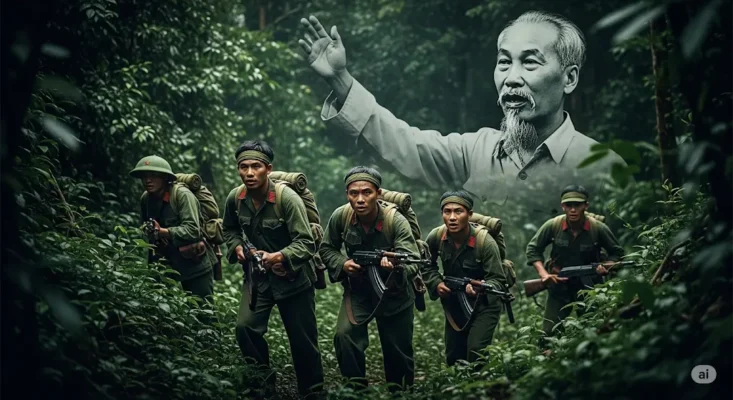
Mid-20th century was transformative for Vietnam, defined by Ho Chi Minh‘s leadership and Viet Minh‘s efforts. After nearly a century of French colonization, desire for sovereignty peaked. World War II’s end created a power vacuum. Ho Chi Minh used it to declare independence. France didn’t recognize this, leading to the First Indochina War, one of several Southeast Asian conflicts.
The Viet Minh, initially an umbrella for nationalist groups, became the primary force for a unified, independent Vietnam. Their resilience, strategy, and popular support were critical against a major colonial power. This era shows Vietnamese agency shaping outcomes. The path led to the Geneva Accords, ending one war but sowing seeds for another. The Indochina Wars are a key focus for those researching this period.
The August Revolution and Declaration of Vietnamese Independence
August 1945, after Japan’s WWII surrender, the Viet Minh under Ho Chi Minh launched the August Revolution. Viet Minh forces quickly took Hanoi and key cities. On September 2, 1945, in Hanoi, Ho Chi Minh declared independence of the Democratic Republic of Vietnam. His speech quoted the U.S. Declaration of Independence. This moment, Vietnam’s independence declared in 1945, was monumental in vietnamese history.
It symbolized culmination of anti-colonial struggle. The path to recognized independence was far from over. France was determined to reassert authority. This declaration began a new, intense phase for freedom.
The First Indochina War: Key Battles and Figures like Vo Nguyen Giap
French refusal to recognize independence led to the First Indochina War (December 1946). This conflict pitted French Union’s forces against Viet Minh, led militarily by General Vo Nguyen Giap, a brilliant strategist. The war featured Viet Minh guerrilla tactics against a superior French army. Key battles showed Viet Minh strength. The war culminated in the Battle of Dien Bien Phu (1954).
Vo Nguyen Giap‘s forces besieged and overran a fortified French garrison. The Viet Minh were victors at Dien Bien Phu, a stunning French defeat with global impact. It signaled colonialism’s decline. Main belligerents, France and Viet Minh, suffered heavy casualties.
The Geneva Accords and the Division of Vietnam
After Dien Bien Phu, the 1954 Geneva Conference negotiated an end to the First Indochina War. The Geneva Accords of 1954 had a profound outcome: Vietnam was temporarily divided at the 17th parallel. North Vietnam (Democratic Republic of Vietnam) governed by Ho Chi Minh from Hanoi. South Vietnam (State of Vietnam, later Republic of Vietnam) in Saigon, under Bao Dai then U.S. influence. Accords stipulated 1956 national elections for reunification. These never occurred, due to South Vietnam/U.S. opposition fearing communist victory. This division solidified North-South ideological division, setting stage for the Vietnam War, a key Cold War event and defining chapter of history about vietnam.
The Vietnam War: Conflict from Hanoi to Saigon and the Road to Reunification
The Vietnam War (American War in Vietnam) is a tumultuous, defining chapter in vietnam history. Stemming from unresolved division and Cold War tensions, it pitted communist North Vietnam against U.S.-backed South Vietnam. The war ravaged the country, from Hanoi (North) to Saigon (South, former name of Ho Chi Minh City). It was fought in villages, jungles, hearts, and minds.
Consequences of the Vietnam War for civilians were immense: loss, environmental damage (Agent Orange, a chemical defoliant), social upheaval. The Ho Chi Minh Trail was a legendary supply route. Conflict ended with Saigon‘s fall and reunification under communist rule. A hard-won victory for the North, but immense suffering for all. Understanding causes and timeline of the Vietnam War is a primary search intent. The Vietnam War start date is often cited as 1955 by some.
The Division of North and South Vietnam (Republic of Vietnam)
Failure of 1956 reunification elections entrenched Vietnam’s division. North Vietnam, under Ho Chi Minh, focused on socialism and supporting southern insurgency. South Vietnam, Republic of Vietnam (RVN), led by Ngo Dinh Diem, established an authoritarian anti-communist state with U.S. backing. Diem faced internal opposition: Buddhists, and the National Liberation Front of South Vietnam (NLF, or Viet Cong). The NLF’s full name reflected its broad coalition. This ideological/political chasm, fueled by external powers (U.S., Soviet Union), made Vietnam a Cold War battleground. Division was geographical and deeply ideological.
Major Phases and Turning Points of the War, including the Tet Offensive
The Vietnam War escalated through phases. Initial U.S. involvement was advisors/aid. Mid-1960s saw U.S. combat troop deployment after Gulf of Tonkin incidents. War involved large-scale U.S. bombing (North) and ground operations (South). The Tet Offensive (1968) was a turning point. North Vietnamese/NLF forces launched surprise attacks across South Vietnam. Militarily a setback for attackers, Tet had profound psychological impact in U.S., eroding war support. U.S. strategy was reassessed. The Ho Chi Minh Trail and Agent Orange were key aspects. This military history was complex.
The Fall of Saigon and the Reunification of Vietnam
After Tet, U.S. began “Vietnamization,” withdrawing troops, aiming to bolster South Vietnam’s army. Paris Peace talks were protracted. January 1973 Paris Peace Accords officially ended direct U.S. military involvement. Fighting between North/South continued. Early 1975, North Vietnam launched a final offensive. South Vietnamese army collapsed rapidly without direct U.S. support. April 30, 1975, North Vietnamese tanks entered Saigon, leading to surrender. This ended the Vietnam War. It led to formal reunification as Socialist Republic of Vietnam (1976). Reunification Day, April 30 1975, is a major holiday. Ho Chi Minh City became Saigon‘s new name, symbolizing a new era in this brief vietnam history.
Inspired by Vietnam’s Rich History?
Witness the echoes of the past and the vibrant present of this incredible nation. Start planning your journey to Vietnam today!
Find the best flight deals to explore historical sites from Hanoi to Ho Chi Minh City:
Post-Reunification Vietnam: Rebuilding, Reform, and Navigating the Modern Era
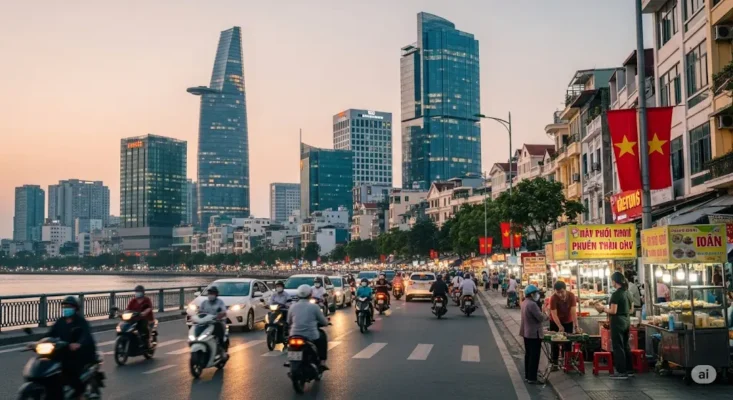
War’s end (1975) and reunification (1976) began a new, challenging era in vietnam history. Rebuilding a devastated society and economy was monumental. Initial years saw attempts at centrally planned socialism and social re-education. These policies, plus international isolation and war’s effects, caused severe economic hardship. Recognizing need for change, Vietnam launched Doi Moi reforms (mid-1980s).
This transition saw Vietnam open its economy, integrate globally, and achieve remarkable growth. Contemporary Vietnam plays an active role in Southeast Asia and globally. It balances economic development with its political system and addresses its past’s consequences. The future of Vietnam is shaped by these processes.
Challenges of Post-War Reconstruction
War’s aftermath presented huge challenges. The country was scarred: infrastructure destroyed, lands damaged by bombing and chemicals like Agent Orange, millions of casualties/displaced. Integrating the South into a unified socialist state was hard. The government faced international embargoes (U.S.), hampering recovery. Border conflicts with Cambodia and China (late 1970s) strained resources. Centrally planned economy struggled, leading to shortages. This period showed difficulty transitioning from war to peace. Primary sources offer direct evidence of these struggles.
The Doi Moi Reforms and Economic Transformation
By mid-1980s, the economic model was unsustainable. In 1986, the Party initiated Doi Moi (“Renovation”). This reform aimed for a “socialist-oriented market economy.” Doi Moi encouraged private enterprise, foreign investment, de-collectivized agriculture, liberalized prices. Results were transformative. Vietnam saw rapid economic growth, poverty reduction, global integration (ASEAN 1995, WTO 2007). This economic history shift improved living standards. It changed Vietnam’s international standing. Doi Moi unleashed energy, setting a new development path. The history of vietnamese economic recovery is remarkable.
Vietnam’s Contemporary Role in Southeast Asia and the World
Today, Vietnam is influential in Southeast Asia and globally. Its location, growing economy, young population contribute. Vietnam is key in ASEAN, contributing to regional cooperation. It hosted major international events (APEC). It maintains multilateral foreign policy. Challenges remain: maritime disputes, environment, equitable development. Contemporary Vietnam looks to the future, built on a millennia-spanning history of resilience. The story of vietnam history evolves. The nation is proud of its past, ambitious for its future. Understanding Vietnamese politics today needs this appreciation. The Ao Dai and Bamboo remain cultural symbols.
Further Reading: Explore More About Vietnamese Culture & Heritage
- Discover Deep-Rooted Vietnamese Traditions (https://essentialvietnamtravel.com/vietnamese-traditions/)
- An Introduction to Vietnamese Traditional Dress and Clothing (https://essentialvietnamtravel.com/vietnamese-traditional-dress-introduction-vietnams-clothing/)
- Understanding Modern and Traditional Vietnam Attire (https://essentialvietnamtravel.com/vietnam-attire/)
- Your Ultimate Guide to Vietnamese Holidays and Celebrations (https://essentialvietnamtravel.com/ultimate-vietnamese-holidays-guide-rich-traditions/)

